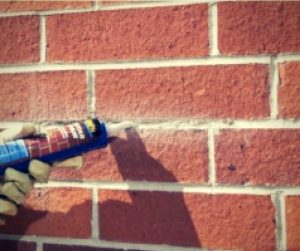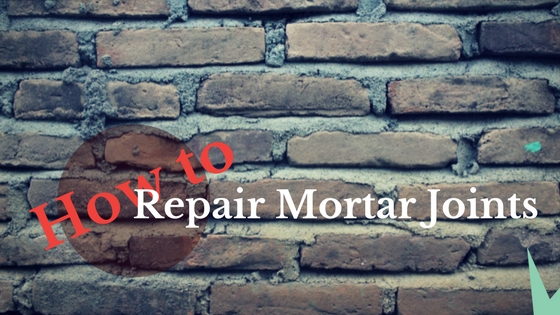How to Repair Mortar Joints
After years of exposure to the elements, joints between brick (head, vertical mortar, and bed, horizontal mortar) can begin to crack away or even fall out. There are, however, some basic ways to fix brick joints to have walls looking great again. Following is some advice on how to repair mortar joints in brickwork.
Joints in Masonry: Brick and Mortar and What Causes Cracking
 When brick is laid, first, two thin lines of mortar (“mud,” in standard masonry speak) are spread out on concrete or on other brick. Brick is then placed on top of this, and this mortar dries, and is “jointed,” or shaped, to become the bed joint, which forms long and horizontal lines under brick. It is the joint over and under bricks that is between stacked bricks. When bricks are placed side by side, mud is set between their ends, and this shorter, vertical mortar representing brick height is known as the head joint.
When brick is laid, first, two thin lines of mortar (“mud,” in standard masonry speak) are spread out on concrete or on other brick. Brick is then placed on top of this, and this mortar dries, and is “jointed,” or shaped, to become the bed joint, which forms long and horizontal lines under brick. It is the joint over and under bricks that is between stacked bricks. When bricks are placed side by side, mud is set between their ends, and this shorter, vertical mortar representing brick height is known as the head joint.
After drying, there are several causes that can lead to mortar deterioration. Most of them stem from uneven mixing before its original installation. Cement, sand and water go into the mixer to make mud, and often, clumps of sand or already hardened cement (usually from bags exposed to water) fail to break up, and persist as small, powdery clumps in the mortar. Over time, precipitation, freezing weather, and very hot weather can cause cracking and crumbling, especially in weak spots where this was applied. Sometimes, though, the problem is foundational: Shifting ground below can cause joints to crack or fall out.
Check Out: Simple Fixes for Common Household Problems
How to Mix Mud to Repair Mortar Joints
 A few key supplies are needed to mix and apply mortar, and to grind out the crumbled or cracked, dried mud from the original installation. Following are necessary supplies
A few key supplies are needed to mix and apply mortar, and to grind out the crumbled or cracked, dried mud from the original installation. Following are necessary supplies
- Bag(s) of cement mix with lime
- Sand
- Water
- Wheel barrow or tub for mixing, or mortar mixer for large amounts
- Shovel
- Trowel
- Tuck pointer
- Electric grinder
- Jointer, to match original work
For each bag of cement, about five gallons of water and 18 full shovels of sand should make the right mix. If using a mixer, turn it on, add water, and then spill the mix into the mixer. Then, shovel in sand until the right consistency, which looks like fresh ice cream (it is wet but thick and has small creases) results, after about 18 shovel-fulls. If mixing in a wheel barrow, add sand and cement, and stir that around, pouring portions of the five gallons of water in slowly, until everything has been mixed well.
If making smaller quantities of mud, try mixing three to four parts sand with one part cement mix, adding in water, and stirring everything about until the right consistency results.
How to Repair Mortar Joints
![]() First, remove broken, dried mud from joints with the grinder. Clear whole joints if necessary, to make sure that no future problems result from the previously used, imperfect mortar.
First, remove broken, dried mud from joints with the grinder. Clear whole joints if necessary, to make sure that no future problems result from the previously used, imperfect mortar.- Mix mud. Work out of the wheel barrow, or pour some mortar in a pan, cover the rest, and set the pan near the work station. Dip a trowel into the freshly mixed mud to get some of it on the tip of the bottom side of the blade. Holding the trowel upside down, so that the mud is on the upper side of the blades tip, tilt it up, and quickly flick the wrist forward, and stop once the blade is horizontal, over the pan or wheel barrow; this downward jerking motion will make the mud bond to the blade, even if it is tilted upside down, until it is rubbed off in the joint gaps. A standard tuck pointer works for small creases, which a trowel may be to big for.
- Then, gently dab the mud into the cracks or gaps. If filling large gaps, apply the mortar liberally: it likely will want to fall out sometimes if too little is used to fill the spaces. Then, after it begins to harden, a brick jointer may be used to remove the excess mud and shape the joint.
- Fill all gaps or cracks with the fresh grout, and then later, when it begins to dry, use the jointer to shape the brick joints and remove the excess mud. On colder days, it can take several hours before the mud begins to stiffen, and on hot summer days, it can take minutes. Joint the freshly applied mud before it dries completely, but after it has hardened to the consistency of dried earth mud.
- If the remainder of the mixed mortar begins to dry, it will need a shake up.
Learning how to repair mortar joints to fix brick can take some time, and it may include some frustration. The trowel is the mason’s tool, and it can take practice to get its use down, at which point applying mud to cracks becomes easy.



 First, remove broken, dried mud from joints with the grinder. Clear whole joints if necessary, to make sure that no future problems result from the previously used, imperfect mortar.
First, remove broken, dried mud from joints with the grinder. Clear whole joints if necessary, to make sure that no future problems result from the previously used, imperfect mortar.